See the UK's oldest colour photos, plus more from around the world
- Oops!Something went wrong.Please try again later.
The world in true colour
![<p>Jean Desboutin / Royal Trust Collection [Public domain]</p>](https://s.yimg.com/ny/api/res/1.2/CeVX9F5BJrR8ludKi3SsEg--/YXBwaWQ9aGlnaGxhbmRlcjt3PTk2MDtoPTYxOQ--/https://media.zenfs.com/en/loveexploring_uk_835/f8e6d576f44063e683f9764d16493a18)
Jean Desboutin / Royal Trust Collection [Public domain]
While photography was all the rage after it was invented in the 1830s, its lack of colour quickly had people clamouring for more. Photographers began to hand colour black and white prints, but they didn't quite capture real life in its true form – and at their worst they looked like bad paintings.
After several attempts by enterprising scientists, it was Auguste and Louis Lumière who came up with the most practical and financially viable option of the age – autochrome. Patented in 1903, it hit the shelves in 1907 and dominated the world of photography for the next 30 years, becoming "probably the most beautiful photographic process ever invented," according to the National Science and Media Museum.
Read on to discover the world as it looked in the earliest genuine colour photographs...
c.1906: Suzanne Lumiere, Louis Lumiere's eldest daughter, France
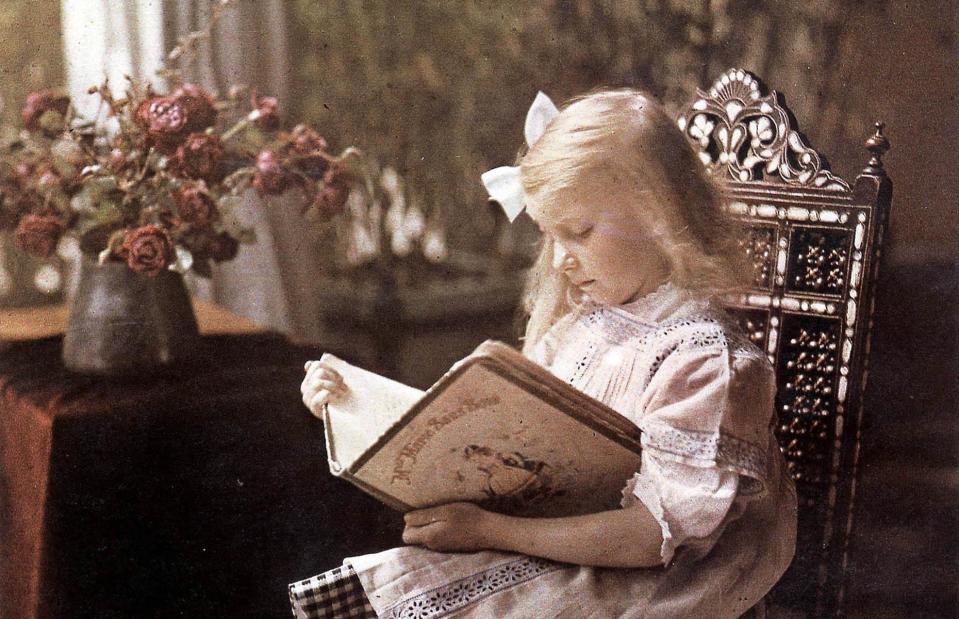
Apic / Getty Images
The Lumière brothers photographed still lifes in their studio, as well as portraits of their family members, such as this charming scene of Louis Lumière's eldest daughter Suzanne, presumably at home. Autochrome plates were handy as they could be used in photographers' existing cameras, but their design – whereby light passed though a plate covered in microscopic grains of dyed potato starch and photographic emulsion – meant the exposure times were around 30 times that of black and white plates.
c.1907: Boat trip to Flavigny, France
![<p>Julien Gérardin / Wikimedia Commons [Public domain]</p>](https://s.yimg.com/ny/api/res/1.2/Etmk8Qy8Q2c6f2Fd05_ROg--/YXBwaWQ9aGlnaGxhbmRlcjt3PTk2MDtoPTYxOQ--/https://media.zenfs.com/en/loveexploring_uk_835/0a487123c8552c698405584f836a7b66)
Julien Gérardin / Wikimedia Commons [Public domain]
While it was harder to capture movement using autochrome, it gave images the serene, almost dreamlike quality you see here. First available in France, photographers such as Julien Gérardin took to it quickly, breaking out of the studio and capturing life as it unfolded around them, such as this tranquil boat ride.
1908: Mark Twain towards the end of his life, Redding, USA
![<p>Alvin Langdon Coburn / Wikimedia Commons [Public domain]</p>](https://s.yimg.com/ny/api/res/1.2/FNxVPxJooMc5uRwje_LVOw--/YXBwaWQ9aGlnaGxhbmRlcjt3PTk2MDtoPTYxOQ--/https://media.zenfs.com/en/loveexploring_uk_835/3193a513d9df2a8e7c3931be38dc5702)
Alvin Langdon Coburn / Wikimedia Commons [Public domain]
One of the first great names of the age to be captured in colour was the renowned American writer, Mark Twain. US-born British photographer Alvin Langdon Coburn learned the autochrome technique while visiting Paris in 1906-1907, and went on to photograph the Adventures of Huckleberry Finn author at his home in Redding, Connecticut a year later. Twain died in 1910.
1910: Schoolchildren in Harvard, USA
![<p>Charles C. Zoller / George Eastman House / Wikimedia Commons [Public domain]</p>](https://s.yimg.com/ny/api/res/1.2/o7xejnUlctbTk2zilO4B1Q--/YXBwaWQ9aGlnaGxhbmRlcjt3PTk2MDtoPTYxOQ--/https://media.zenfs.com/en/loveexploring_uk_835/91591ffeb4f798f34a56c3e84da37f38)
Charles C. Zoller / George Eastman House / Wikimedia Commons [Public domain]
It wasn't just famous names who got the autochrome treatment, however. Photographers such as Charles C. Zoller caught everyday scenes, such as this group of school children standing with their teachers under magnolia trees on Oxford Street in Harvard, Massachusetts. On a sunny day, exposure would take around a second, but that could go right up to 10 seconds on a cloudy day.
As we can see, a few of the children couldn't stay still that long, hence the slight blurring of their faces.
1912: Stagecoaches in Ghent, Belgium
![<p>Alfonse Van Besten / Wikimedia Commons [Public domain]</p>](https://s.yimg.com/ny/api/res/1.2/lcTz8T7NNv9LYJQFg8zI6A--/YXBwaWQ9aGlnaGxhbmRlcjt3PTk2MDtoPTYxOQ--/https://media.zenfs.com/en/loveexploring_uk_835/c3de4b5a4a2528829a06819d0f516c73)
Alfonse Van Besten / Wikimedia Commons [Public domain]
Despite being a painter by trade, Alfonse Van Besten embraced technology and favoured autochrome to photograph everything from dramatic tableaux to scenes from daily life in his home country of Belgium. These tall, covered stagecoaches were captured as they waited on the Korenlei – or 'corn quay' – on the bank of the Leie river in the historic centre of Ghent.
1912: Adults and children pose in front of a farm in Oberfelden, Germany
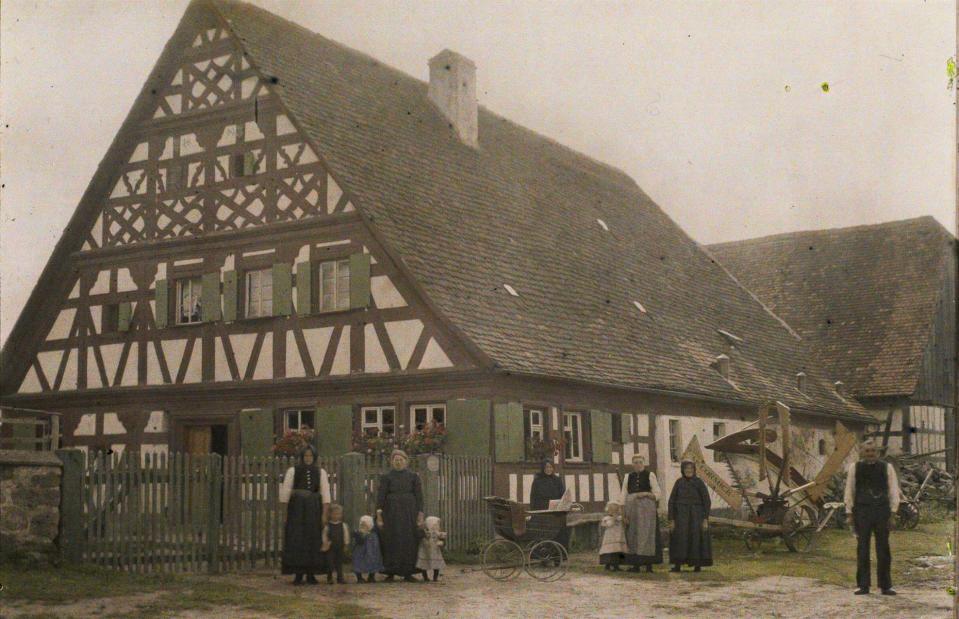
The Archives of the Planet / Alamy Stock Photo
From 1908, French banker Albert Kahn sponsored The Archives of the Planet, a massive project to photograph cultures around the world. It ran until 1931, when it was halted after Kahn's fortune took a massive hit in the stock market crash of 1929.
However, in that time 72,000 colour photographs were taken in 50 countries, including this image, shot by renowned autochrome photographer Auguste Léon. It shows a group posing by a traditional farmhouse in the village of Oberfelden, which lies about an hour west of Nuremberg.
1913: Christina paddling in the sea, Dorset, UK
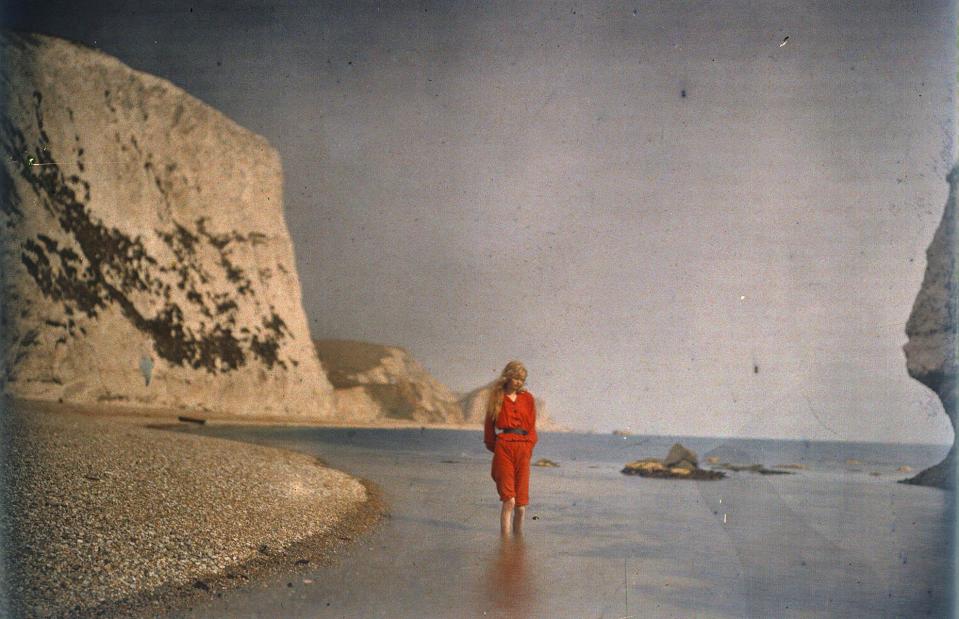
The Royal Photographic Society Collection / Victoria and Albert Museum, London / Getty Images
Although taken in 1913, Mervyn O'Gorman's series of a woman named Christina became an internet sensation over 100 years later. The photos were taken in Dorset, England including this one at Lulworth Cove.
They have a serene, "almost surreal" quality, which appealed to those who saw them at the Drawn by Light exhibition, held in 2015 by the National Science and Media Museum in Bradford, West Yorkshire, England. The long exposure time gave the sea an "unreal glass-like quality" while the vivid red of her costume led the Daily Mail to dub her "the original lady in red" and El Pais to name her a "Flickr pin-up for the 20th century".
1913: Women and children standing near dilapidated houses in Cornwall, UK
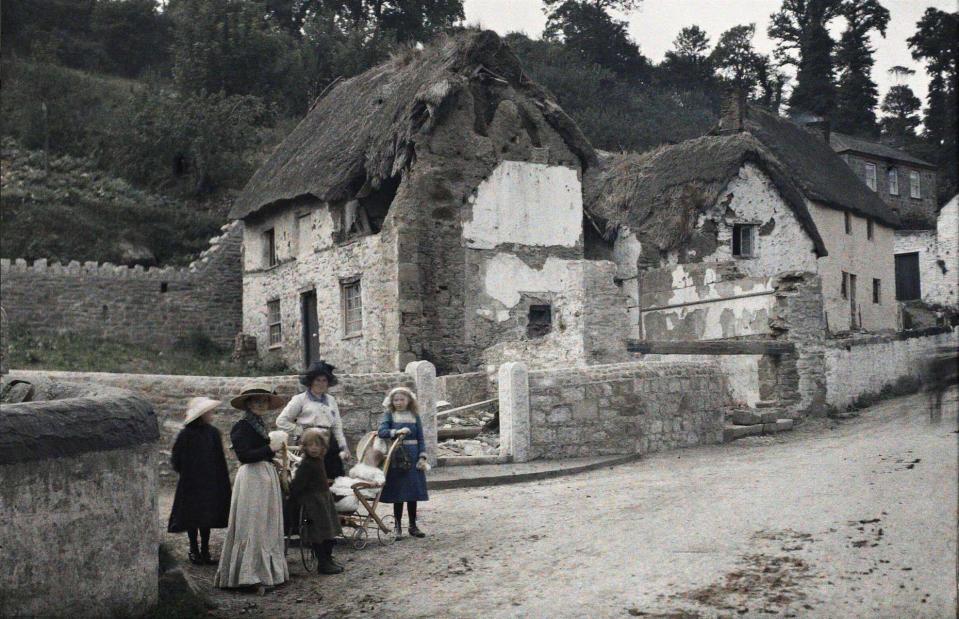
The Archives of the Planet / Alamy Stock Photo
We take another trip to the English seaside in this autochrome of women and children standing outside a pair of derelict thatched houses in Cornwall, taken by Auguste Léon in the late summer of 1913. As well as shooting the landscapes and locals of Cornwall, he also captured his patron Albert Kahn's holiday home in Carbis Bay.
1913: Serb women in festive dress, Prizren, Kosovo
![<p>Auguste Léon / Wikimedia Commons [Public domain]</p>](https://s.yimg.com/ny/api/res/1.2/EtjMqvtN_Km9iyAH.gOkPA--/YXBwaWQ9aGlnaGxhbmRlcjt3PTk2MDtoPTYxOQ--/https://media.zenfs.com/en/loveexploring_uk_835/2ed4ac197899b70f54f3e0f4b0ec3df6)
Auguste Léon / Wikimedia Commons [Public domain]
Léon captured a very different scene when he travelled to Kosovo, where he caught subjects from seed sellers to soldiers in autochrome. He photographed this group of Serb women in festive dress near Prizren in May 1913.
Unsurprisingly, the two very young children sitting at the women's feet were too fidgety to sit still for the full exposure, resulting in two very blurred little faces.
1913: Market stalls at Luxor Temple, Egypt
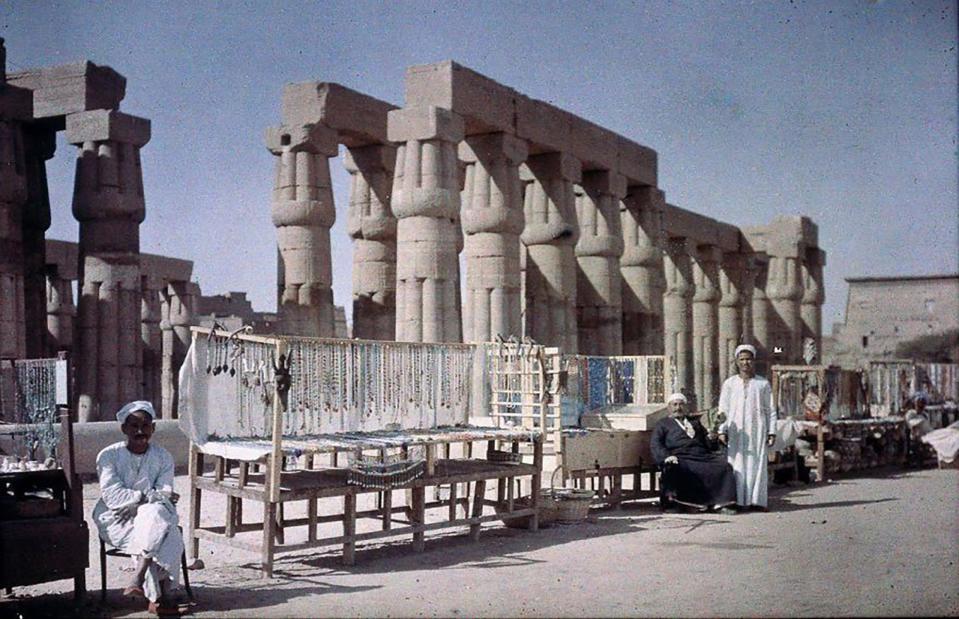
Friedrich Adolf Paneth / Public domain
Partially thanks to Lord Carnarvon and Howard Carter's excavation of Thebes (in modern day Luxor), which began in 1907, Egypt became a place of fascination for the west. In 1913, Austrian-born British chemist Friedrich Paneth and his wife honeymooned in Egypt, where he took a series of autochromes.
This one shows local vendors in front of a colonnade, most likely at the ruins of the Temple of Amun at Karnak.
1913: People waving from the old bridge in Mostar, Bosnia and Herzegovina
![<p>Albert Kahn / Wikimedia Commons [Public domain]</p>](https://s.yimg.com/ny/api/res/1.2/5Z5Atr_eclJykS05rq5ufw--/YXBwaWQ9aGlnaGxhbmRlcjt3PTk2MDtoPTYxOQ--/https://media.zenfs.com/en/loveexploring_uk_835/a2d5fcc20b5eb9f7b89237e2577461bd)
Albert Kahn / Wikimedia Commons [Public domain]
Albert Kahn himself was a keen photographer and he captured the beautiful Stari Most or 'old bridge' in Mostar, Bosnia and Herzegovina, in April 1913. It was built under Suleiman the Magnificent in 1557, but it collapsed in November 1993 when it was hit by shells during the Croat-Bosniak War.
The war ended three months later and Stari Most was rebuilt as closely as possible to the original, eventually reopening in July 2004. It is now a National Monument and UNESCO World Heritage Site.
1913: Riders of the Mongolian Postal Service, near Ulaanbaatar, Mongolia
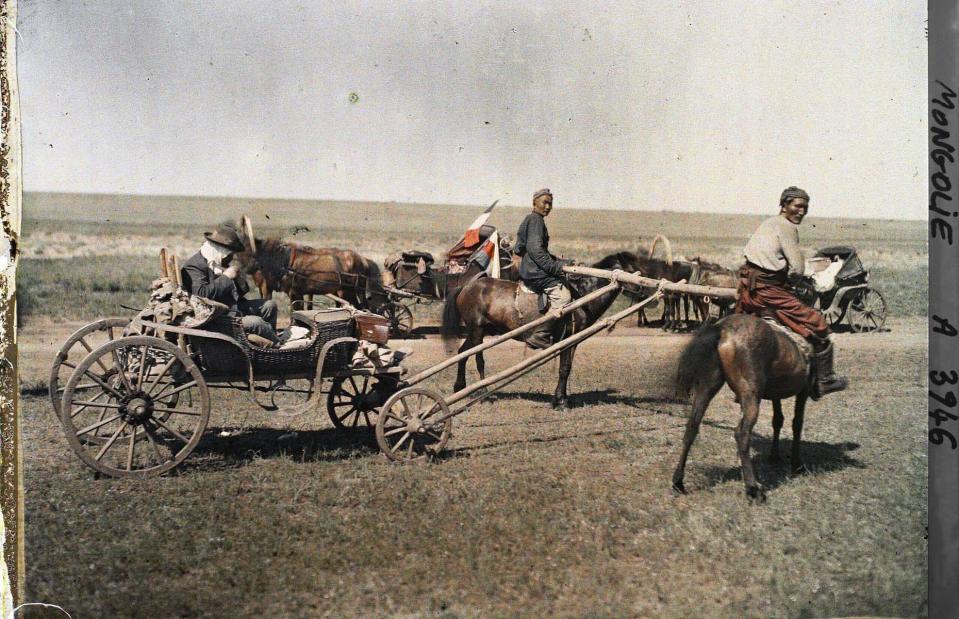
The Archives of the Planet / Alamy Stock Photo
Somewhere in the wilds of Transbaïkalie, between Kyakhta in Russia and Ourga (modern day Ulaanbaatar) in Mongolia, photographer Stéphane Passet met the riders of 'La Poste Mongole', the Mongolian postal service. He caught a country on the brink of change in a stunning series of autochromes, just after it declared independence from China yet before it became the Mongolian People's Republic in 1924.
c.1913: Hot air balloons in the Grand Palais, Paris, France
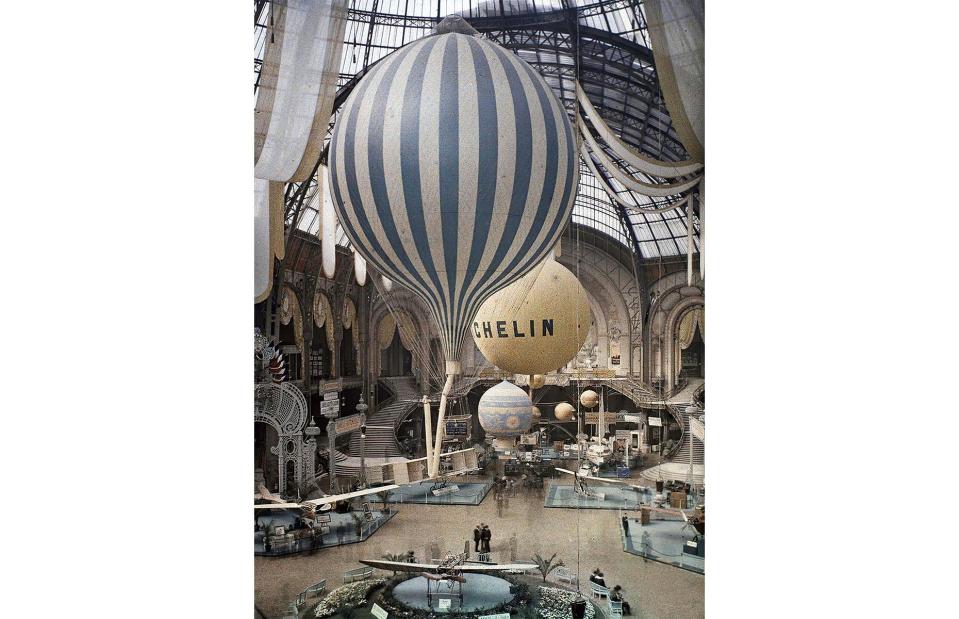
Gado / Getty Images
The Paris Air Show dates back to 1909, and was held each year in the Grand Palais, which had originally been built for the 1900 Paris Exposition. This image, taken by Léon Gimpel, shows hot air balloons on display at the fair in around 1913.
While Gimpel used autochrome to capture still lifes and landscapes, he was dissatisfied by the long exposure time, so he – along with fellow photographer Fernand Monpillard – modified the plates to produce 'instant' colour images. In doing so, he was able to capture the Belle Époque in all its dazzling glory, before it was brought to an end by the First World War.
1914: A mounted police rider with his horse, Edmonton, Canada
![<p>Hugo Viewegar / Flickr / Provincial Archives of Alberta [Public domain]</p>](https://s.yimg.com/ny/api/res/1.2/U8rKVWlOWxkT5vs_500sXw--/YXBwaWQ9aGlnaGxhbmRlcjt3PTk2MDtoPTYxOQ--/https://media.zenfs.com/en/loveexploring_uk_835/f56ebf11acc846241fbf9dbd478f95e6)
Hugo Viewegar / Flickr / Provincial Archives of Alberta [Public domain]
Formed in 1873, the Royal North-West Mounted Police was a paramilitary force tasked with keeping law and order in the then-new Canadian North-West Territories. Its formation was prompted by the Cypress Hills Massacre, in which a party of Canadian and American wolf hunters and whiskey traders killed 13 Nakoda men after accusing them of horse theft.
Six years after this autochrome was taken of a Royal North-West Mounted Police musical rider with his steed, the force was merged with the Dominion Police to create the Royal Canadian Mounted Police, which still exists today.
1914: A man fills a water jug from a fountain in Cordoba, Spain
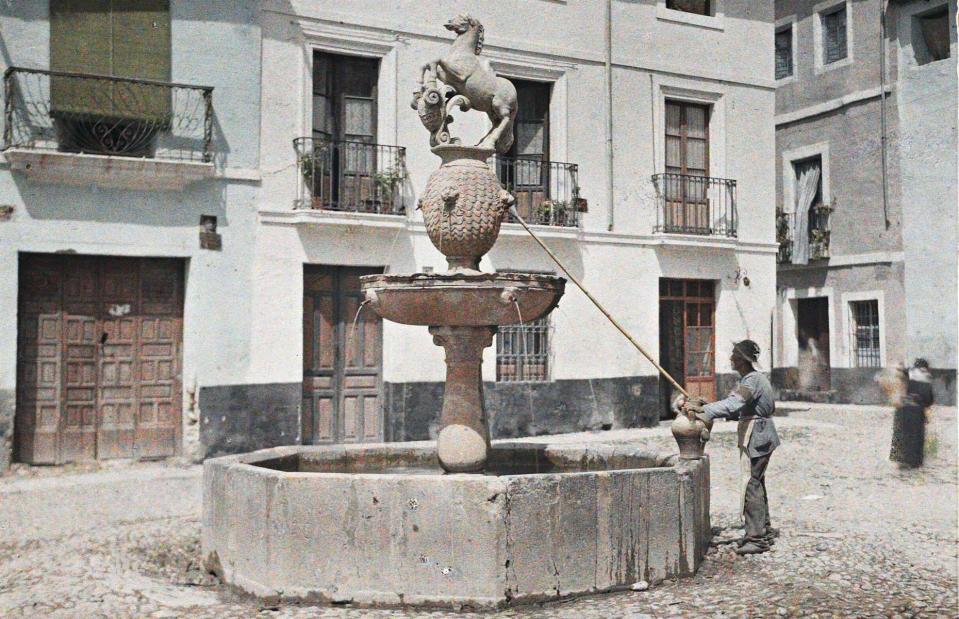
The Archives of the Planet / Alamy Stock Photo
Europe was teetering on the edge of war when this image was taken in summer 1914. The world was about to change forever, yet for this man – snapped collecting water via a long pipe from the Fontaine Place del Potro in Cordoba, Spain – life goes on as normal.
Spain remained neutral throughout the First World War, so it escaped the damage some other European nations endured. In fact, this fountain and the houses that surround it still exist today and look almost exactly as they did back then.
1914: The Eiffel Tower and the Trocadero, Paris, France
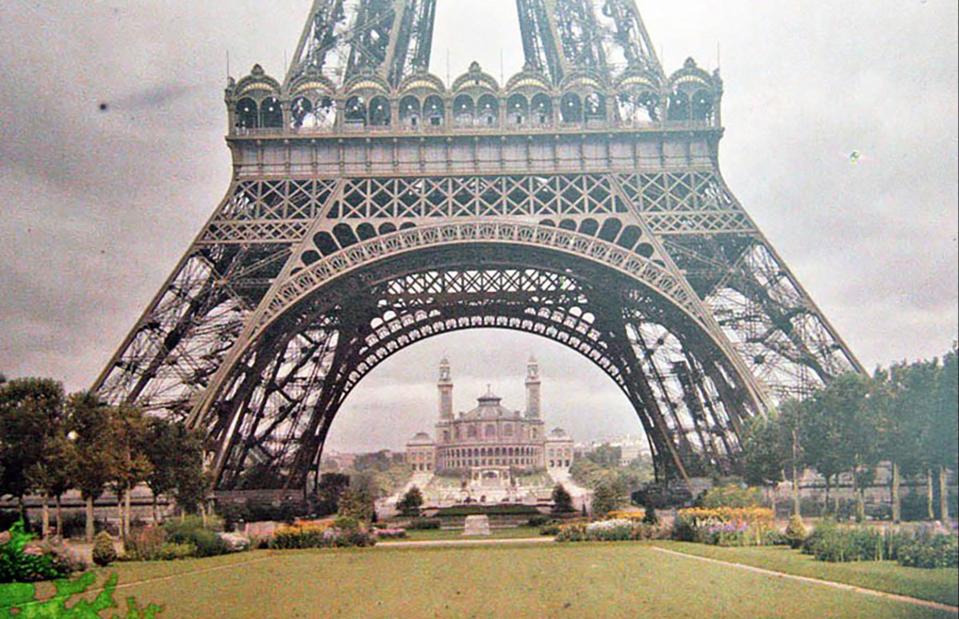
Auguste Léon / Public domain
During the month in which the First World War was officially declared, this iconic image was snapped of the Trocadero Palace, seen through the iron legs of the Eiffel Tower. Originally built for the 1878 Exposition Universelle, the Trocadero Palace was an unusual mix of Moorish and Neo-Byzantine architectural styles.
While its appearance was criticised, it stood for 60 years before it was dismantled in 1935 to make way for the Palais de Chaillot, which was constructed for the 1937 Exposition Universelle and still stands today.
1914: King George V and Queen Mary, Buckingham Palace, UK
![<p>Jean Desboutin / Royal Trust Collection [Public domain]</p>](https://s.yimg.com/ny/api/res/1.2/1oVLoirgTft0gHmyYFRNTA--/YXBwaWQ9aGlnaGxhbmRlcjt3PTk2MDtoPTYxOQ--/https://media.zenfs.com/en/loveexploring_uk_835/1c164f6a1fc069574c84c2b6793125de)
Jean Desboutin / Royal Trust Collection [Public domain]
Elsewhere, royalty was embracing the new colour technology. Just as Prince Albert and Queen Victoria had been early enthusiasts of photography, so too was their grandson, King George V.
For the royal portrait, the King wore the Admiral of the Fleet uniform, while his wife, Queen Mary, wore a green dress and the Queen Consort's Crown. The image was taken in Buckingham Palace, London and is one of several autochromes taken that day of the royal family, including their eldest son, Edward VIII, later the Duke of Windsor.
1915: The crew of the Endurance play football on ice
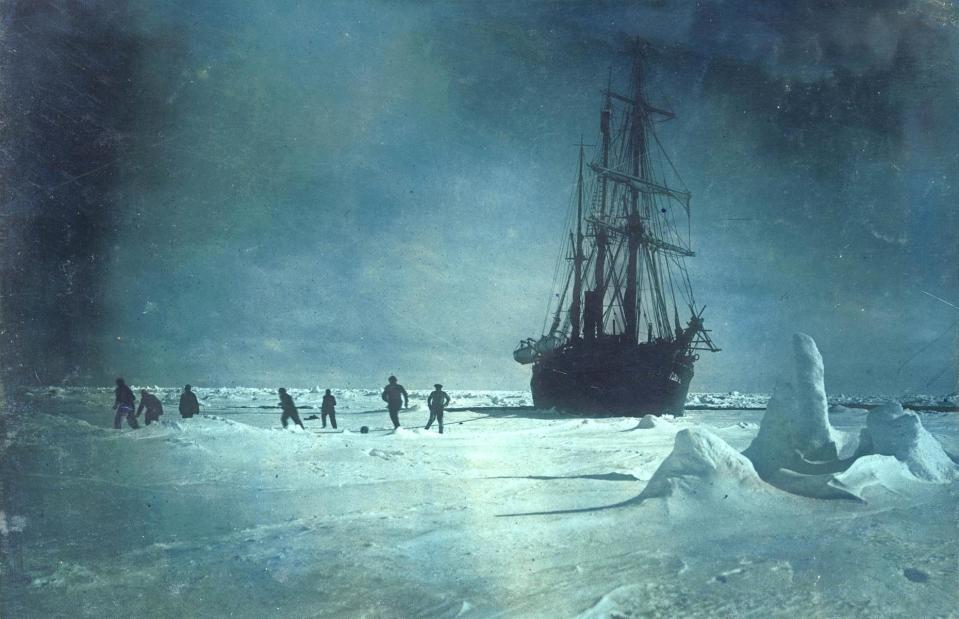
Frank Hurley / Scott Polar Research Institute, University of Cambridge / Getty Images
Far away from war, Ernest Shackleton embarked on his doomed Imperial Trans-Antarctic Expedition to the South Pole. By the time this image was taken, Shackleton's ship, HMS Endurance, was trapped by pack ice. Australian expedition photographer Frank Hurley took this photo of the crew playing football on the floe before the ship was crushed by the pressure.
It sank leaving the 28 men stranded. They endured months of hardship until they were rescued in an extraordinary tale of survival. Hurley used an early polychrome process called Paget instead of autochrome to capture their ordeal.
Paget used two plates to create a negative and was patented in England in 1912. To process the plates, Hurley set up a darkroom in the ship and wrote in his journal that it was "extremely difficult" to work in, due to the -13°C (8.6°F) temperature outside.
When the Endurance sank, he dove down into icy water to retrieve his negatives and film.
1915: Women enjoying the gardens of the Palace of Horticulture, San Francisco, California, USA
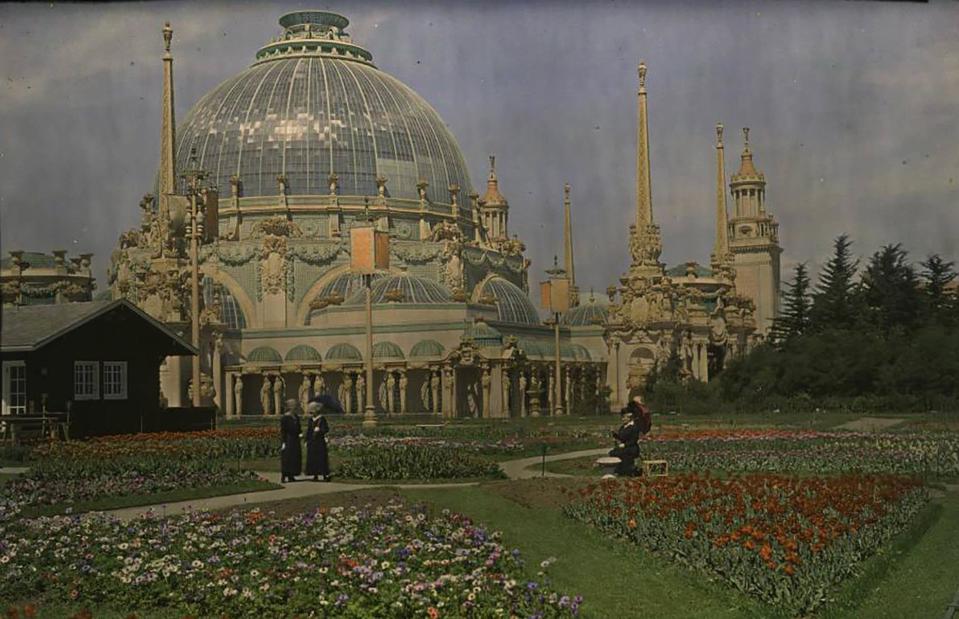
Unknown author / Public domain
Over in America, San Francisco hosted the Panama-Pacific International Exposition, to celebrate the completion of the Panama Canal, as well as to showcase the city's recovery from the deadly earthquake of 1906. One of the many extraordinary buildings erected for the event was the Palace of Horticulture, pictured.
While a few of the original buildings still survive, including the impressive Palace of Fine Arts, the Palace of Horticulture was dismantled.
c. 1915: German troops sheltering in a trench in Champagne, France
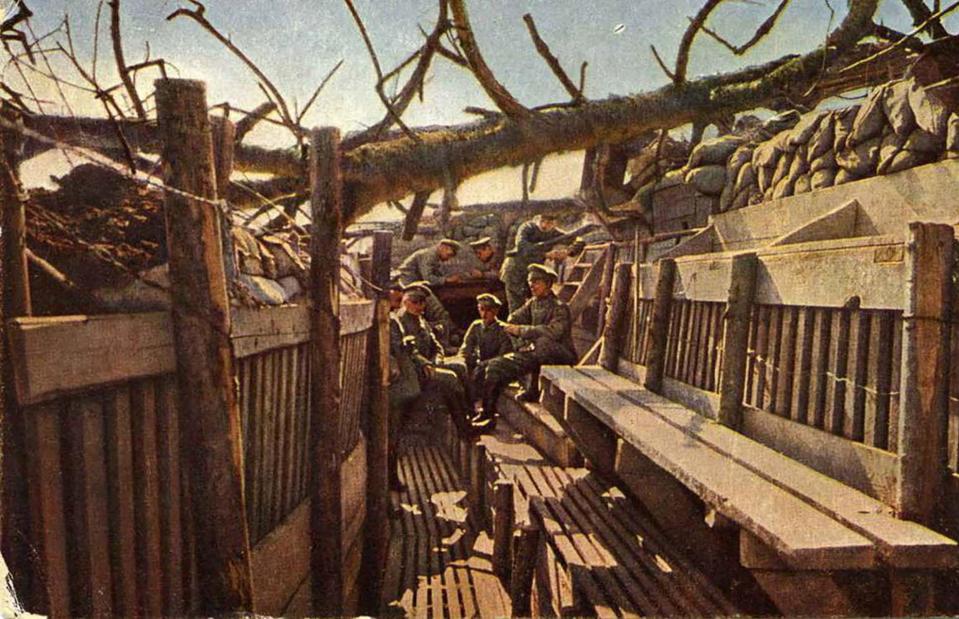
Hans Hildenbrand / Public domain
In Europe, the First World War waged on and autochrome had been invented just in time to portray it in all its shocking detail. Hans Hildenbrand had been an early adoptee of autochrome and was one of 19 photographers employed by Kaiser Wilhelm to document the war.
He was the only one to take colour photos. Embedded with a German platoon in Champagne from June 1915 to January 1916, he mostly captured posed scenes due to autochrome's long exposure time.
1915: Algerian soldiers, Pas-de-Calais, France
![<p>Jean-Baptiste Tournassoud / Wikimedia Commons [Public domain]</p>](https://s.yimg.com/ny/api/res/1.2/wIh8AeDtKNIeImO8k5C5TA--/YXBwaWQ9aGlnaGxhbmRlcjt3PTk2MDtoPTYxOQ--/https://media.zenfs.com/en/loveexploring_uk_835/87eefc577cb3b28b76e3587e83a6d033)
Jean-Baptiste Tournassoud / Wikimedia Commons [Public domain]
For the first time, people were able to see soldiers from around the world, as well as their often-colourful uniforms. Jean-Baptiste Tournassoud used autochrome to full effect to capture these Algerian soldiers at the Spahis camp in Pas-de-Calais, an area of northern France.
Spahi originally comes from the Persian word for a cavalry soldier from the Ottoman Empire, and came to refer to Indigenous units of the Army of Africa. During the First World War, they were known to be tireless soldiers and earned commendations for their bravery.
1917: Bomb crater, Messines Ridge, Belgium
![<p>Fernand Cuville / Wikimedia Commons [Public domain]</p>](https://s.yimg.com/ny/api/res/1.2/Zypomx6CK_oTnhzdJ.G4IQ--/YXBwaWQ9aGlnaGxhbmRlcjt3PTk2MDtoPTYxOQ--/https://media.zenfs.com/en/loveexploring_uk_835/8221de69b6d2abedc46168149c4a39a0)
Fernand Cuville / Wikimedia Commons [Public domain]
This extraordinary image shows a crater measuring 380 feet (116m) across by 147 feet (45m) deep. It was left after British soldiers dug beneath German lines in West Flanders and detonated 19 mines containing 21 tonnes of explosive on 7 June 1917.
Around 10,000 soldiers died, including almost all of the 3rd Royal Bavarian Division. The blast is said to be one of the biggest non-nuclear explosions in history and was audible in Dublin and London.
The Second Anzac Corps fought at the Battle of Messines, including the New Zealand Division; it was one of the most successful allied operations on the Western Front.
1917: Destroyed fort, Ham, France
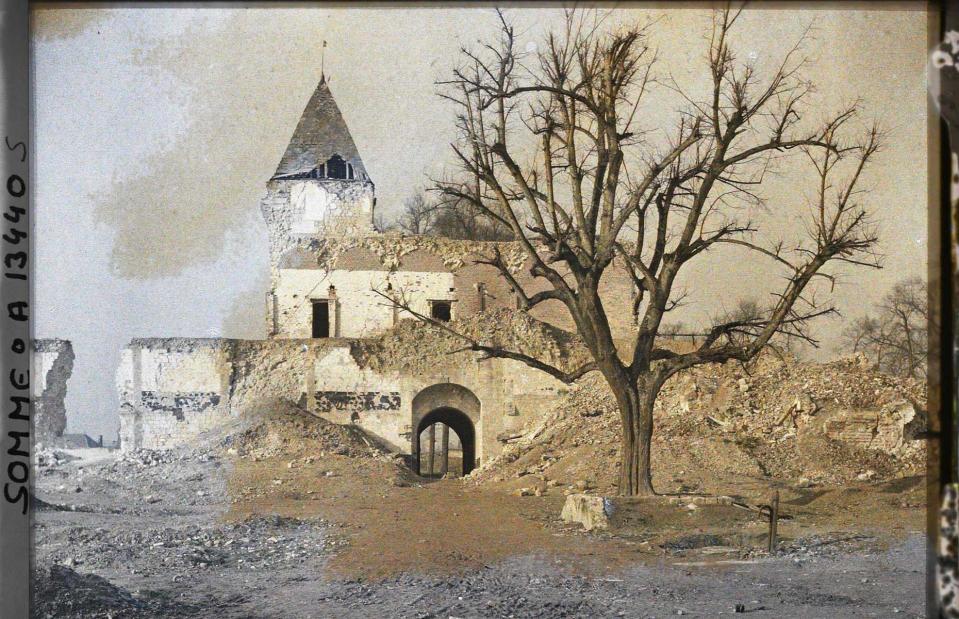
The Archives of the Planet / Alamy Stock Photo
As well as countless lives, whole villages and towns across mainland Europe were devastated. This autochrome image shows the village of Ham, in the Somme region of France in September or October 1917.
German forces dynamited this historic medieval fortress, a small part of which remains today. Prior to its destruction, it had served as a state prison for centuries and held prisoners including Joan of Arc in the 15th century and Napoleon III from 1840. He lived in a small apartment in the prison, which he dubbed the "University of Ham" as he was allowed to study and conduct experiments there.
He escaped after six years and fled to England.
1918: Australians of the Imperial Camel Corps near Rafah, Egypt
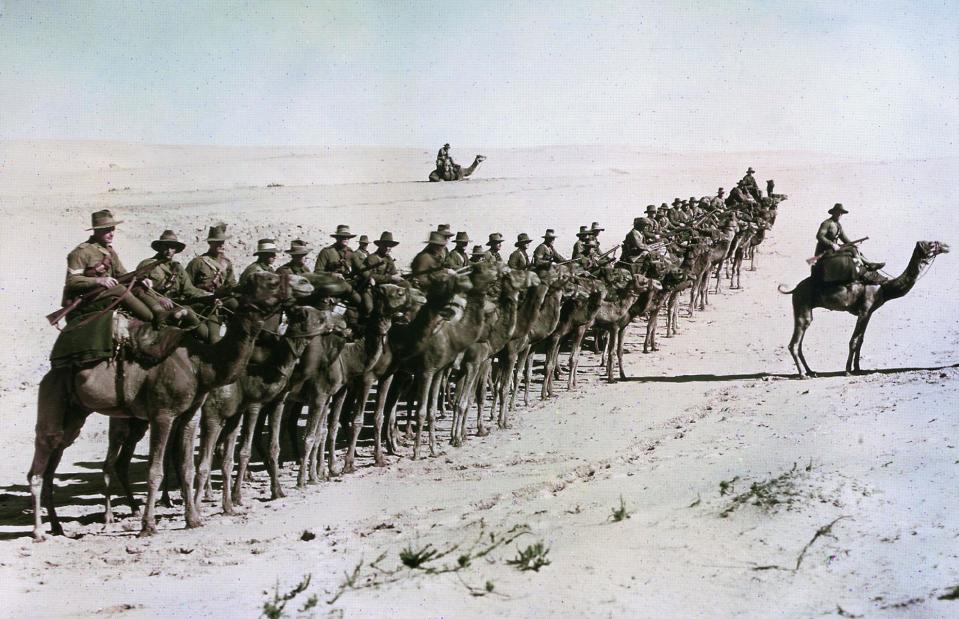
Galerie Bilderwelt / Getty Images
By January 1918, troops from around the world were fighting in the Middle Eastern during the First World War. Frank Hurley – the same photographer who documented Shackleton's voyage – shot this Paget image of Australian soldiers of the Imperial Camel Corps near Rafah, Egypt.
The Corps was made up of Australian, British, New Zealand and Indian troops, as well as additional soldiers from Hong Kong and Singapore, and played a vital role in several desert campaigns of the war.
1918: Four camel ambulances, Rafa, Egypt
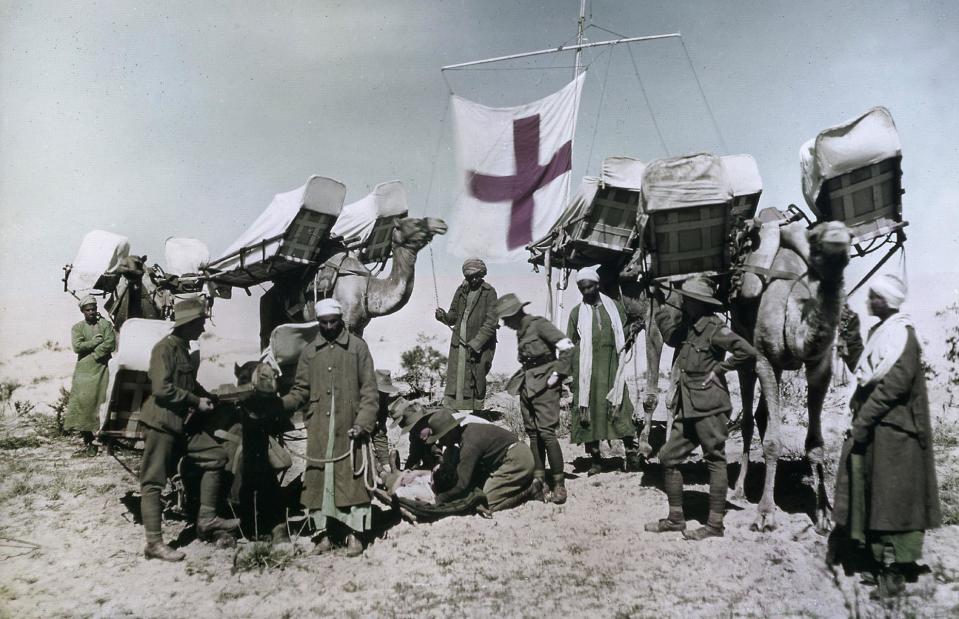
Galerie Bilderwelt / Getty Images
Hurley also captured this unusual sight. It shows four camel ambulances, which were attached to the Imperial Camel Corps. They're flying a Red Cross banner to indicate their role as medics.
Members of the Corps joined Colonel TE Lawrence (aka Lawrence of Arabia) during the Sinai and Palestine Campaign, one of the many roles for which he became renowned.
1919: Allied troops parade through London, UK
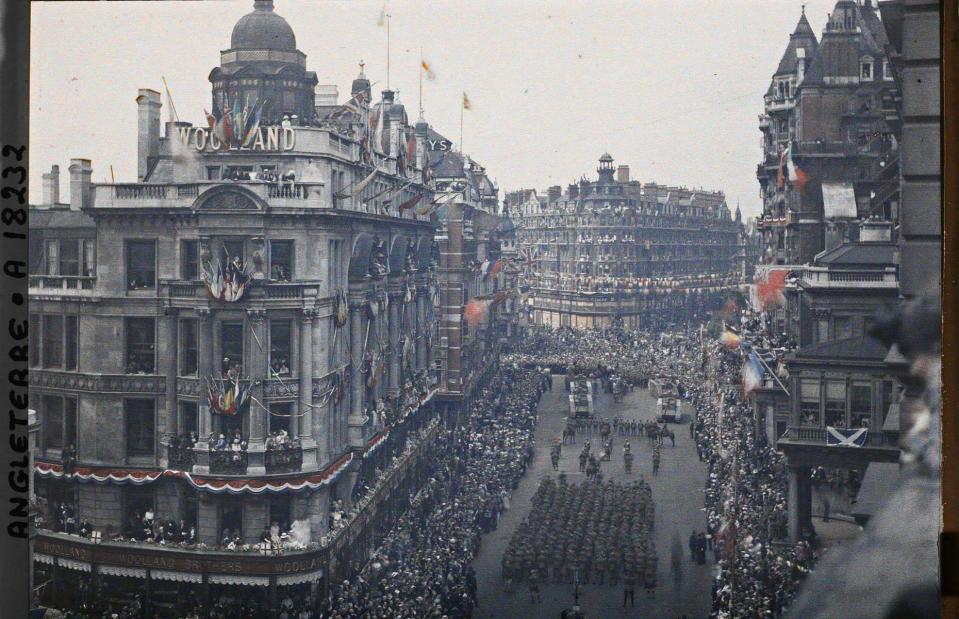
The Archives of the Planet / Alamy Stock Photo
After an estimated 16.5 million soldiers and civilians had died, the First World War drew to a close with Armistice on 11 November 1918. This image was taken by French war photographer Fernand Cuville in July 1919, as allied troops were honoured as they marched through the streets of London, England.
1926: An elephant awaits the Maharaja of Jaipur, India
![<p>Jules Gervais-Courtellemont / Wikimedia Commons [Public domain]</p>](https://s.yimg.com/ny/api/res/1.2/..4608vh35s8NX744iiT2w--/YXBwaWQ9aGlnaGxhbmRlcjt3PTk2MDtoPTYxOQ--/https://media.zenfs.com/en/loveexploring_uk_835/fd3dff2fc7820b66b1455eafcac68dd8)
Jules Gervais-Courtellemont / Wikimedia Commons [Public domain]
As the Roaring Twenties got underway, intrepid photographers continued to travel the globe, sending back spectacular colour images that harked back to the Belle Époque. Here, French photographer Jules Gervais-Courtellemont caught servants waiting with a state elephant for the Maharaja of Jaipur at his palace in India.
1927: Children posing at Muotathal in the Engadine, Switzerland
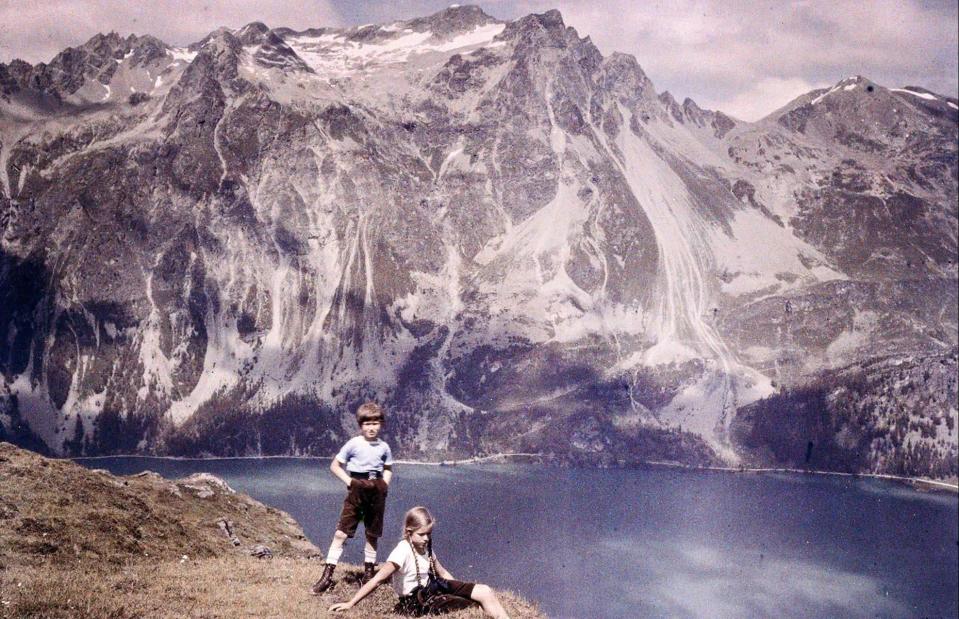
Friedrich Adolf Paneth / Public domain
Friedrich Paneth, who we last saw honeymooning in Egypt, took this autochrome of his children, Eva and Heinz, while holidaying in Switzerland in August 1927. Due to his Jewish roots, Paneth later fled his native Austria to escape the Nazis, and settled in Britain, where he became a naturalised citizen in 1939.
A decorated chemist as well as a photographer, he has both a mineral and a moon crater named after him.
1928: A policeman directs traffic in Trafalgar Square, London, UK
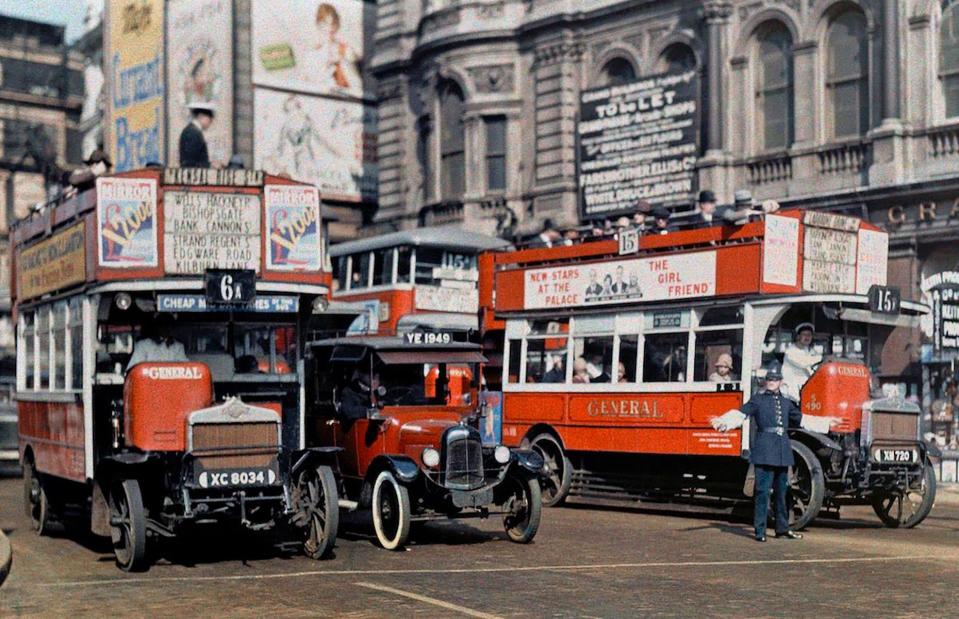
Clifton R. Adams / Public domain
American photographer Clifton R. Adams travelled to England from America in 1928 to capture life in Britain. He snapped everyone from bus conductors and farmers to elderly Second World War veterans and children enjoying a day at the seaside.
He died at the age of 34, just six years after he took this photo.
1954: Queen Elizabeth II and Prince Philip arrive in Tasmania, Australia
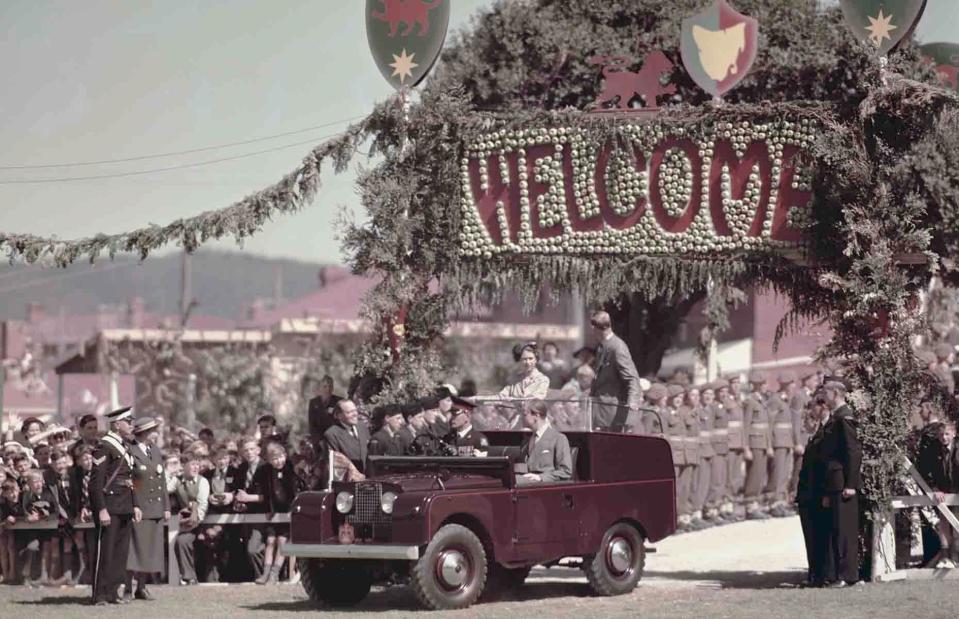
Fox Photos / Hulton Archive / Getty Images
Despite the massive popularity of autochrome, by the 1930s photographers were moving away from plates and towards film. While several manufacturers invented new options, it was Kodachrome that became the future of colour photography.
Invented by two American musicians and with the support of Kodak Research Laboratory, 35mm Kodachrome film hit America in 1936 and the UK in 1937. This image of the late Queen Elizabeth II and Prince Philip arriving at Parliament House in Hobart, Tasmania, during their Commonwealth Tour of Australia in 1954, was taken on such a film.

